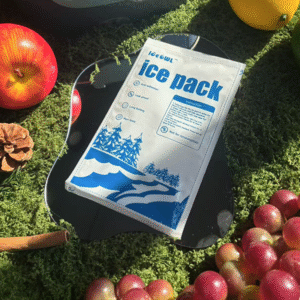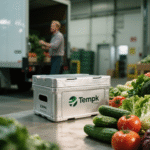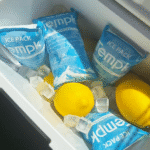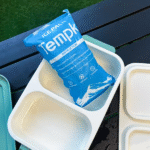Shipping sensitive items isn’t just about keeping things cool – it’s about protecting their quality and value. Refrigerated dry ice packs provide ultra cold temperatures without melting, making them indispensable for pharmaceuticals, biologics, seafood and gourmet meal kits. These packs sublimate at –78.5 °C (–109.3 °F), so they can keep products frozen much longer than gel or water packs. As the cold chain market climbs from USD 228.3 billion in 2024 to USD 372.0 billion by 2029 and dry ice consumption grows despite CO₂ supply constraints, choosing the right refrigerant is more important than ever.

What refrigerated dry ice packs are and why they matter – understanding their composition and the sublimation process.
How to choose between dry ice, gel packs, water packs and reusable packs – exploring cost, performance and environmental impacts.
Best practices for selecting and using refrigerated dry ice packs – considering shipment type, duration, regulations and safety.
Industry specific insights and emerging trends for 2025, including smart packaging and sustainability.
Frequently asked questions to help you make informed decisions.
Let’s explore how you can leverage refrigerated dry ice packs to keep your products safe and your operations efficient.
What Are Refrigerated Dry Ice Packs and Why Are They Essential?
Defining Refrigerated Dry Ice Packs
Refrigerated dry ice packs are moulded blocks or pellets of solid carbon dioxide (CO₂) encased in protective materials. Unlike gel or water packs that melt and release liquid, dry ice packs sublimate directly from solid to gas. This means no puddles or condensation damage – a critical advantage for moisture sensitive items like pharmaceuticals and microelectronics. Because dry ice maintains extremely low temperatures (around –78.5 °C or –109.3 °F), it can keep frozen goods like seafood or biologics at ultra cold conditions for extended periods.
The sublimation process absorbs heat as CO₂ turns into gas, providing steady cooling throughout transit. Placing the packs inside insulated containers slows sublimation and prolongs the cooling duration. Modern dry ice packs are often vacuum sealed or wrapped in polymer films to prevent direct contact and reduce frost bite risk, making them safer for handlers.
Extended Cooling Without Melting
Dry ice’s ability to remain solid at ultra low temperatures makes it ideal for shipments that must stay below freezing. Gel packs typically maintain 2–8 °C for 24–48 hours, while water packs are better for chilled (not frozen) goods. Dry ice packs, however, can keep items frozen for days, especially when combined with high quality insulation. This extended cooling power means fewer refrigerants are required for long journeys, reducing both weight and costs.
No Liquid Residue
Since dry ice vaporizes without leaving liquid, there’s no risk of soggy packaging. Gel and water packs, on the other hand, can leak if punctured, contaminating food or pharmaceuticals. This makes dry ice particularly valuable for shipping items in cardboard or other moisture sensitive packaging.
Market and Industry Importance
The dry ice market is growing rapidly. Consumption has been increasing about 5 % per year, yet CO₂ supply has grown only 0.5 % annually, leading to periodic shortages and price volatility. Despite these challenges, demand is projected to push the market from USD 1.54 billion in 2024 to USD 2.73 billion by 2032 (7.4 % CAGR). This growth is fueled by biologic therapies, vaccines, frozen foods and industrial applications such as blasting and welding.
At the same time, the broader cold chain market – encompassing storage, transportation and packaging – is projected to reach USD 372.0 billion by 2029. Europe currently holds 33.7 % of the cold chain packaging market, thanks to stringent food safety regulations and pharmaceutical expansion. Innovations like smart packaging with IoT sensors are further driving demand for reliable refrigerants.
How Dry Ice Sublimation Works
Dry ice sublimates when its surface absorbs heat from the surrounding environment. For every kilogram of CO₂ that sublimates, it absorbs about 570 kilojoules of heat, delivering powerful cooling. This process produces CO₂ gas, which needs to be vented to prevent pressure build up. That’s why insulated containers used with dry ice packs include pressure relief vents or perforations.
Sublimation rates depend on several factors:
Insulation quality – high performance materials such as vacuum insulated panels slow heat transfer and reduce the rate of sublimation.
Ambient temperature – warmer conditions accelerate sublimation; planning for extra dry ice in summer months is essential.
Package size and fill – more mass equals a slower sublimation rate, so larger blocks of dry ice last longer than small pellets.
Ventilation – adequate venting prevents pressure build up and ensures safety for handlers.
Understanding these variables helps you estimate how much dry ice is required for your shipment. The table below summarizes typical recommendations.
| Shipment Type | Recommended Dry Ice Amount | Estimated Duration | Why it Matters |
| Pharmaceutical samples (–20 °C to –70 °C) | 5–10 lbs per 24 h | 24–72 h | Ensures vaccines and biologics remain viable at ultra cold temperatures. |
| Seafood and meats (–18 °C to –20 °C) | 1–2 lbs per 24 h | 24 h | Maintains frozen state without freezer burn. |
| Biotech or research samples | 5 lbs per 24 h | 48 h | Protects DNA or cell samples during transit. |
| Meal kits & frozen foods | 2–3 lbs per 24 h | 24 h | Keeps ready to heat meals frozen until delivery. |
Practical Tips and Safety Guidelines
Always wear insulated gloves and eye protection when handling dry ice. Direct contact can cause frostbite.
Store packs in well ventilated areas; CO₂ gas can displace oxygen and cause asphyxiation in enclosed spaces.
Label packages properly. Many carriers require a “Carbon Dioxide, Solid” label and specify limits on dry ice weight per parcel.
Plan for sublimation losses. Dry ice can dissipate within 12–24 hours depending on conditions; factor this into your shipment schedule.
Real world example: A biotech startup shipped gene therapy vectors from San Francisco to New York using Tempk’s dry ice packs. By packing 7 lbs of dry ice and using a high density insulation liner, they maintained –65 °C for 60 hours. The company avoided temperature excursions and preserved the sample’s potency, illustrating how careful planning ensures product integrity.
Choosing the Right Refrigerated Dry Ice Pack for Your Needs
The right cooling solution depends on what you’re shipping, how long it will be in transit and your operational constraints. Here’s how to choose wisely.
Temperature Requirements and Product Sensitivity
Ultra cold goods (below –20 °C) – Items like vaccines, insulin, gene therapies and frozen meats require extremely low temperatures. Dry ice packs excel here because they maintain –78.5 °C and last longer than other options. For fragile biologics, avoid overcooling by using insulation and separating dry ice from the product with cardboard or foam.
Refrigerated goods (2–8 °C) – For fresh produce, dairy or ready to eat meals, gel or water packs are often sufficient. Gel packs maintain 2–8 °C for 24–48 hours and are non toxic and safe to handle. Water packs cost less and are simple to dispose of but provide less thermal retention.
Room temperature goods (15–25 °C) – Phase change materials (PCMs) or reusable cold packs can stabilize ambient products. These solutions can be recharged, making them ideal for subscription services or closed loop logistics.
Shipment Duration and Size
Estimate how long your shipment will be en route. For transits under 24 hours, a moderate amount of dry ice (2–3 lbs per 24 h) may suffice. For multi day shipments, consider adding more dry ice or mixing it with gel packs to maintain both frozen and chilled zones. Larger packages require more dry ice to offset heat gain.
Use the following formula as a starting point:
Dry ice weight (lbs) = (shipment duration in hours / 24) × required pounds per day
Adjust for seasonal conditions: more dry ice is needed during summer or in hot climates.
Regulatory and Safety Considerations
Shipping regulations – Carriers like FedEx and UPS impose limits on dry ice quantity (usually up to 5.5 lbs for air shipments). Check regulations for ground vs air and international shipping.
Hazard classification – Dry ice is classified as a hazardous material because of CO₂ gas release. Proper labeling and documentation are mandatory.
Handling training – Train your team to use gloves, goggles and proper ventilation to mitigate risks of frostbite and CO₂ accumulation.
Cost and Environmental Impact
Although dry ice is effective, it can be expensive and energy intensive to produce. Moreover, CO₂ sublimation contributes to greenhouse gas emissions. Gel packs are reusable and safer but may contain non recyclable materials. Water packs use only frozen water and have the lowest environmental impact, yet they offer less cooling power. Reusable cold packs have higher upfront costs and require a return program.
Assess your priorities: if carbon footprint is a primary concern, consider reusable or water packs with adequate insulation. For mission critical shipments, the reliability of dry ice may outweigh environmental trade offs. Hybrid solutions – combining gel packs for chilled zones and dry ice for frozen sections – offer flexibility and reduce overall CO₂ usage.
Comparing Cooling Solutions
The following table compares the main refrigerant options across key criteria (adapted from industry sources):
| Cooling Method | Best Use | Cost & Eco Impact | Ease of Use | Cooling Power | What It Means for You |
| Dry ice packs | Frozen goods (seafood, vaccines) | High cost, moderate eco impact; CO₂ sourced from industrial by products | Requires gloves and ventilation | Excellent – can keep items frozen for days | Ideal for ultra cold shipments; plan for regulations and safety. |
| Gel packs | Chilled goods (2–8 °C) | Medium cost, moderate eco impact; non toxic but difficult to recycle | Safe and easy to handle | Good – maintains temperature for 24–48 h | Great for fresh food and pharma that must not freeze. |
| Water packs | Short duration chilled shipments | Low cost and low eco impact – just frozen water | Very easy to handle and dispose | Moderate – lower thermal mass than gels | Budget friendly choice for meal kits or groceries; use more packs to increase cooling. |
| Reusable cold packs | Closed loop logistics, subscription services | Low cost over time; low waste but requires cleaning | Moderate – infrastructure for return and refreezing required | Variable – can be tailored for chilled or frozen | Best when return logistics are feasible; reduces disposable waste. |
Actionable Tips
For ultra low shipments (e.g., vaccines): Use dry ice packs and separate them from the product with cardboard spacers. Monitor temperatures with IoT sensors for compliance.
For e commerce meal kits: Combine gel packs with water packs to maintain 2–8 °C and avoid freezing. Use more water packs during summer.
For subscription services: Invest in reusable cold packs. Provide customers with a return label and instructions to send them back.
Real world example: A food delivery service switched from gel packs to a hybrid water pack/dry ice system. The company used water packs for chilled ingredients and a small dry ice compartment for frozen meats. The change reduced packaging costs by 15 % and improved product freshness, while meeting sustainability goals.
Comparing Refrigerated Dry Ice Packs With Other Cooling Methods
Gel Packs: Flexible and Convenient
Gel packs are reusable pouches filled with non toxic gel. They maintain refrigerated temperatures (2–8 °C) for 24–48 hours. Their advantages include reusability, safety and flexibility; they don’t require special handling and can be refrozen after use. However, they can leak if punctured and may be more expensive than simple water packs. Gel packs are ideal for chilled pharmaceuticals, prepared meals and fresh produce.
Water Packs: Low Cost and Eco Friendly
Water packs are essentially frozen pouches of water. They’re extremely affordable, safe to handle and easy to dispose of because they simply melt into water. Their lower thermal mass means they may require more units to achieve the same cooling as gel packs. Water packs are perfect for short duration chilled shipments or when budget and sustainability are top priorities.
Reusable Cold Packs: Sustainable Choice
Reusable cold packs, often used in closed loop logistics, are durable gel or water packs designed for multiple cycles. They reduce waste and offer low long term costs. However, they require return logistics, cleaning and refreezing infrastructure. They’re excellent for subscription boxes, pharmaceutical delivery or B2B shipments where you can recover the packs. When reused at high return rates, they have a low environmental impact.
Dry Ice vs Ice Packs: Key Differences
According to CK Supply, dry ice maintains much colder temperatures and lasts longer than standard ice packs, making it indispensable for keeping items frozen. Ice packs are safer to handle and suitable for products that need to stay cool but not frozen. Dry ice requires protective gear and ventilation, while ice packs don’t. Environmentally, dry ice sublimates into CO₂, whereas ice packs are reusable and produce no harmful emissions.
Factors to Consider When Choosing Between Cooling Options
Product type: Frozen goods need dry ice; chilled goods are better served by gel or water packs.
Packaging materials: Use waterproof containers if using gel or water packs; ensure venting for dry ice.
Shipping costs: Dry ice shipments can be costly due to weight and hazard surcharges. Gel packs are more cost effective for shorter trips.
Customer handling: If customers are unfamiliar with dry ice, gel or water packs offer simpler handling.
Environmental impact: Water and reusable packs have lower footprints; dry ice is more sustainable than chemical refrigerants but still releases CO₂.
Industry Specific Applications and Case Studies
Pharmaceuticals and Biologics
The pharmaceutical sector relies on precise temperature control to maintain drug efficacy. Tamper evident packaging and temperature sensitive monitoring are mandated by regulators. Dry ice packs combined with smart sensors allow real time monitoring and rapid intervention when temperatures drift. For example, gene therapy samples often require –70 °C storage; using a dry ice and vacuum insulated container can maintain this for 72 hours.
A survey on connected packaging found that ~51.9 % of respondents cited sustainability and recycling as drivers for adoption. As such, pharma companies are increasingly exploring bio based CO₂ sources, such as capturing CO₂ from bioethanol production to reduce carbon footprints. In the UK, a single bioethanol plant provides 30–60 % of the country’s CO₂ supply, highlighting both the potential and risks of relying on a few sources.
Food and Meal Kits
E commerce food deliveries have surged, fueled by the convenience of home dining. MarketsandMarkets reports that the cold chain market is growing at 10.3 % annually, driven by online grocery sales and demand for preserved, fresh meals. For meal kits, using a combination of gel and water packs ensures ingredients stay cool without freezing. A hybrid design with a separate dry ice compartment can keep frozen items like ice cream intact, improving customer satisfaction.
Meal kit companies also care about sustainability. Using reusable cold packs lowers waste and appeals to eco conscious consumers. To encourage returns, provide pre paid shipping labels and rewards. When return rates exceed 50 %, reusable packs outperform single use options in cost and environmental impact.
Seafood and Meat Exports
Seafood and meat exports need to maintain –18 °C to –20 °C for safe transport. Dry ice packs are standard because they deliver consistent low temperatures and leave no water residue. However, because dry ice supply can be tight during peak seasons, shippers are diversifying with phase change materials (PCMs) and improved insulation to reduce the amount of dry ice needed.
Biotechnology and Clinical Trials
Biotech shipments often involve stem cells, DNA samples or investigational drugs, which are highly sensitive to temperature fluctuations. Using IoT enabled packaging with dry ice ensures continuous monitoring and alerts if temperatures deviate from the set range. For global trials, hybrid solutions combining dry ice, gel packs and PCMs allow segments of the package to maintain different temperatures – crucial when shipping multiple specimen types in one box.
Subscription Services and Direct to Consumer Brands
Subscription services (meal plans, pet food, ready to bake kits) thrive on convenience. Reusable cold packs are ideal here, reducing waste and cost when return logistics are feasible. For customers who value sustainability, offering returnable packaging can be a differentiator. Include instructions on how to handle and return the packs, and consider deposit schemes to incentivize returns.
Real world example: A pet food subscription service introduced plant based foam coolers and reusable ice packs. Customers received a discount on future orders for returning the packs. Return rates reached 70 %, cutting packaging waste in half and increasing brand loyalty.
Latest Developments and Trends for 2025
Smart Packaging and IoT Sensors
The cold chain industry is embracing smart packaging with IoT sensors, which provide real time data on temperature, humidity and location. These sensors enable immediate corrective actions if temperature deviations occur, reducing spoilage and ensuring compliance. Smart labels and RFID tags allow seamless tracking and help meet stricter regulatory requirements in North America, Europe and Asia. Sensor costs are falling, making it feasible to embed them in everyday shipments.
AI Powered Route Optimization and Blockchain
Artificial intelligence (AI) is transforming cold chain logistics. AI algorithms optimize routes based on traffic, weather and delivery windows, improving efficiency and reducing fuel consumption. Blockchain technology offers immutable records of product journeys, enhancing traceability and building consumer trust. Leading cold chain providers integrate blockchain to verify compliance with food safety regulations and to detect counterfeits.
Sustainable Refrigeration Solutions
Sustainability is a major trend. Companies are shifting toward bio based CO₂ and solar powered refrigeration units. Solar refrigeration is particularly valuable in regions with limited grid access, reducing food waste and supporting food security. Lightweight, smart shipping containers equipped with IoT sensors are another innovation; they monitor conditions in real time and reduce energy consumption.
Growth of Cold Chain Packaging and Refrigerants
Multiple market reports highlight significant growth in cold chain packaging and refrigerants:
The cold chain packaging market is forecast to rise from USD 30.23 billion in 2024 to USD 74.38 billion by 2033, reflecting a 9.99 % CAGR. Europe leads with a 33.7 % share due to strict regulations and advanced logistics.
The cold chain packaging refrigerants market will grow from USD 2.01 billion in 2025 to USD 4.28 billion by 2034, driven by a 7.7 % CAGR. North America holds a 37 % share and leads innovations in energy efficient and sustainable refrigerants.
The cold chain logistics market is expected to expand from USD 436.30 billion in 2025 to USD 1,359.78 billion by 2034, at a 13.46 % CAGR. The dry ice segment captured the highest market share (55.16 %) in 2024.
The reusable icepacks market is projected to reach USD 374.7 million during 2025–2029, growing at 5.5 % CAGR. This underscores the growing appeal of sustainable, reusable cooling solutions.
Regulatory and Consumer Drivers
Governments worldwide are imposing stricter traceability, labeling and anti counterfeiting regulations. In the food and beverage sector, active and intelligent packaging extends shelf life by 30–50 % in some categories. Consumers are also demanding transparency and sustainability; influences via social media are expanding demand for international cuisines, driving global trade. A 2025 connected packaging survey found that sustainability and recycling motivated 51.9 % of respondents to adopt smart packaging.
Market Implications
The combination of regulatory pressure, consumer demand and technological innovation is accelerating the adoption of refrigerated dry ice packs and alternative refrigerants. Companies that invest in smart, sustainable and flexible packaging will gain a competitive edge. Supply constraints in CO₂ underline the need for hybrid cooling strategies that mix dry ice with gel packs and PCMs. By diversifying refrigerant sources and integrating IoT monitoring, businesses can navigate volatility while reducing waste.
Frequently Asked Questions
Q1: Are refrigerated dry ice packs reusable?
Most dry ice packs are designed for single use because the dry ice sublimates completely. However, the outer packaging can sometimes be refilled if returned. If sustainability is a priority, consider reusable gel or water packs which can be refrozen.
Q2: How long do refrigerated dry ice packs last in transit?
The longevity depends on how much dry ice you use and the insulation quality. On average, dry ice sublimates within 12–24 hours. For longer journeys, use more dry ice or combine it with gel packs to stretch cooling time.
Q3: Is dry ice safe to handle?
Dry ice is safe when handled correctly. Wear insulated gloves and use it in ventilated areas to avoid frostbite and CO₂ buildup. Always label shipments as “Carbon Dioxide, Solid” to comply with regulations.
Q4: Can I use dry ice to ship refrigerated items (2–8 °C)?
Dry ice is generally too cold for refrigerated goods and can freeze them. For 2–8 °C shipments, gel or water packs are better because they maintain chilled temperatures without freezing.
Q5: What’s the environmental impact of dry ice?
Dry ice is made from CO₂ captured from industrial processes, so it doesn’t add new carbon to the atmosphere. However, producing, transporting and storing dry ice requires energy. Reusable packs and water packs have lower footprints.
Q6: How much dry ice should I use per kilogram of product?
A common rule is 2–4 lbs of dry ice per 10 lbs of product per day, depending on insulation and ambient temperature. Adjust upward for longer trips or warmer conditions.
Summary and Recommendations
Refrigerated dry ice packs are a cornerstone of modern cold chain logistics. Their ability to maintain ultra low temperatures, leave no liquid residue and protect sensitive goods makes them indispensable for pharmaceutical, biotech and frozen food shipments. With the dry ice market poised to grow to USD 2.73 billion by 2032 and the cold chain packaging market climbing towards USD 74.38 billion by 2033, demand for reliable refrigerants will only increase.
When selecting a cooling solution:
Assess product requirements. Use dry ice for goods that must stay below –20 °C, but opt for gel or water packs for chilled items.
Calculate proper quantities. Base dry ice amounts on shipment duration, insulation quality and ambient temperature.
Prioritize safety. Train your team on handling dry ice, and comply with carrier regulations.
Consider hybrid solutions. Combining dry ice with gel or water packs can optimize performance and reduce CO₂ usage.
Embrace technology and sustainability. Invest in IoT enabled packaging, biodegradable materials and reusable cold packs to meet regulatory demands and consumer expectations.
By understanding the strengths and limitations of each cooling method and staying informed on emerging trends, you can ensure that your temperature sensitive shipments arrive safely, sustainably and on time.
Internal Link Suggestions
Cold chain market growth and opportunities – explore detailed analysis of market drivers, regional trends and investment insights.
Best practices for dry ice shipping – learn step by step guidelines on handling, packaging and compliance.
Reusable gel packs vs dry ice – compare sustainability, cost and performance across different refrigerants.
Smart packaging and IoT in cold chain – discover how sensors, blockchain and AI are transforming logistics.
Sustainable cold chain solutions – explore eco friendly materials, solar refrigeration and bio based CO₂ sources.
About Tempk
Tempk is a leading provider of advanced cold chain solutions, offering a comprehensive range of dry ice packs, gel packs, insulated bags and smart packaging systems. Our products are designed to ensure optimal temperature control, regulatory compliance and sustainability across pharmaceuticals, food, biotech and other industries. We invest heavily in research and development to deliver innovative solutions like IoT enabled packaging and reusable thermal technologies that help you reduce waste and improve efficiency. Whether you need ultra cold shipping for vaccines or cost effective cooling for meal kits, Tempk’s experts are ready to design a solution tailored to your needs.
Next Steps: Ready to optimize your cold chain? Contact our specialists for a consultation and discover how Tempk’s refrigerated dry ice packs and other solutions can keep your products safe, fresh and compliant in 2025 and beyond.






















